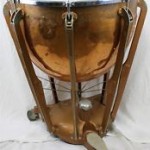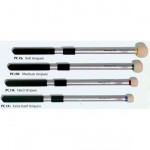My Musical Career | Part Six
As I noted earlier, I began my studies at Manhattan School of Music in September of 1970. While I was excited to be in a totally new learning environment, I was also apprehensive as there was a great deal to be learned, and much that I was totally ignorant of. However, I trusted that with a bit of hard work and some luck I should make a decent showing and have a good first year. In addition to Jim Priess, who was my percussion instructor that first year, there were several other faculty members of note who were both outstanding in their respective fields and also happened to be my teachers at one time or another.
Ensemble Teachers and Ensembles
Freshman were not usually assigned to an orchestra right off the bat, but as percussionists we were assigned to Freshman Percussion Ensemble, and to an orchestral repertory class for winds, brass and percussion. All Percussion Ensemble Classes were under the direction of the Percussion Faculty’s chairman, Paul Price. Paul Price is now remembered as one of the leading exponents of percussion ensemble, and had made the Manhattan Percussion Ensemble into one of the country’s best known college percussion ensemble. He also was a noted free-lance percussion player and longtime member of the American Symphony Orchestra. At the time of m entry into MSM, he was about fifty years of age and at the height of his powers. A very nice man and extremely talented. He also was the owner of Paul Price Publications and as founder of Music for Percussion, was responsible for the commission of many of the basic percussion ensemble standards.
I felt the need of taking part in just more than percussion ensemble, so I signed up for Manhattan Chorus, and having sung in my high school chorus, had had enough of a voice and experience that I was accepted. The director of the chorus at the time was one Robert Hickok. He was of medium height, was balding with a fringe of sandy hair, and while I don’t remember his background, found him to be a tireless and enthusiastic conductor and one that got the most out of his chorus. It was a pleasure to work with him, and I was sad to see him leave MSM, but was also glad to see that he got a promotion as Dean of the North Carolina School of the Arts. I only sang with the chorus for one semester, but it was a good semester as the chorus was readying themselves for a December concert in conjunction with the Manhattan Chamber Orchestra. The program was built around two works. The first was purely an orchestral composition – Haydn’s 103rd Symphony – and was to conclude with Franz Schubert’s Mass No. 5 in A flat for chorus and orchestra. I fell in love with the Schubert from day one and remember most of the tenor part to this day.
I admit that I was envious of the timpanist, Ben Carriel. He was a graduate student who was assigned to the Manhattan Chamber Orchestra for the concert, but as a freshman could only look on from afar. I had met Ben during a visit to the practice room 612. He was doing his timpani practice and was kind enough to take a few minutes to show me the timpani – my first close up look at the 1970s version of the Professional Symphonic timpani.
Nowadays, these would be considered vintage instruments as Ludwig had not yet adopted the idea of suspending the kettle in its own ring- the kettles were still bolted to the frame; as a result the heads were of the non-extended collar type. These had Remo heads on them. As I noted in an earlier blog post, to me they looked like state of the art. Ben also showed me his timpani mallets and gave me some good advice as to what I would be needing. He had a complete set of Hinger-Touch Tone timpani mallets – and I remember that he had replaced the original black grips with surgical tubing. I have to admit that these were the strangest looking mallets that I had seen. I was used to my old Ludwig mallets and was really wet behind the ear when it came to percussion and percussion equipment. This was a defect that would soon be remedied.
The concert came off very well. My parents and older brother and sister came down for the event, which was my first performance at MSM. They enjoyed the concert very much. I sang well and was proud to be a part of such a god ensemble. It was a good way to end the first semester.
Ensemble wise, other than the chorus, the only ensembles that I participated in were freshman percussion ensemble and orchestral rep for winds, brass and percussion. Paul Price directed the ensemble program and had all the ensembles. I confess I was dropped into the deep end of the swimming pool in this class, as I had never experienced percussion ensemble before and had to learn from scratch. Mr. Price was a patient teacher and he introduced us to a lot of excellent percussion ensemble music such as Colgrass’ “Three Brothers”; Robert Buggert’s “Introduction and Fugue” among others.
Orchestral Repertory for Winds, Brass and Percussion, or Orchestral Rep for Winds as it was called was just what its title described. The only section not present was the strings. The percussionists were assigned to the class by the percussion faculty as needed. I was fortunate enough to be assigned to the class in my second semester, and I also took part in my second year as well. Arthur Berv, the former first horn of both the Philadelphia and NBC Symphony Orchestras and a member of the horn faculty at MSM had the class that I was assigned to. We usually practiced in Room 607 or 609, whichever one was available. We usually had to scrounge around for instruments. We were allowed one fully-equipped percussion cart and usually had to poach an available set of timpani – usually the set of Ludwigs from 610 if they were not in use; if they were not available, then the Rogers timpani. I hated those drums – despite the range, which was incredible – they sounded awful and the pedals stuck out so much from the drums, that one could not avoid tripping over the drum when attempting to tune the instrument.
In retrospect, the class taught me the essentials of being a team player. Even though we had to imagine the string parts, Mr. Berv was insistent on good tone quality and proper entrances and intonation. We percussionists had to do a lot of standing around, but a little suffering is good for the soul.
Orchestra
MSM had two orchestras at the time. The most senior orchestra was known as the Manhattan Orchestra, and the junior orchestra was known as the Manhattan Repertory Orchestra. Both orchestras were under the supervision of Maestro Anton Coppola, who was the school’s director of orchestral performance and head of the opera theater. He shared conducting duties with Maestro George Schick, the school’s president who kept his hand on the musical pulse of the school by conducting at least one opera performance and a couple of concerts each year.
The Manhattan Orchestra, in addition to giving three full concerts of its own during the school year, divided itself into two units when there was an opera production scheduled, which was generally three times a year. Half would form the Opera Orchestra and be assigned to that particular opera production. The other half would be called the Chamber Orchestra and either accompany the chorus at its concert, or perform a concert of smaller orchestral works on its own. This orchestra was made up of graduate students, seniors and juniors.
The Manhattan Repertory Orchestra was the training orchestra of the school and generally read through the orchestra repertory with a full ensemble. It also performed as the opera orchestra for the opera workshop. Membership included some juniors, sophomores and an occasional talented freshman. The Repertory Orchestra was my first real experience in orchestral playing, and was the springboard to my later college career and in a sense, to my whole musical career. It also introduced me to my first orchestral conductor, who was one of the most colorful characters at MSM.
Rep Orchestra
I was sufficiently intrigued by the repertory orchestra during my first semester that I would stop in and listen to part of their rehearsals whenever I had the free time. I also made it a habit to listen to the rehearsals and attend the first concert of the season of the Manhattan Orchestra. I had become friendly with Fred Stites, who was a graduate student and who was timpanist for the main work on that program, R. Strauss’s “Death and Transfiguration”. I was lost in admiration for the music and for the skill of the student musicians.
The percussionists in the Rep Orchestra were for the most part friendly and encouraged me to drop by from time to time and listen, and on some occasions when they were short-staffed, which for some strange reason was fairly often that year – to help out. One of the first works that I played (even though it was only being rehearsed for the benefit of the student orchestra) was the First Symphony of Dmitri Shostakovich. The timpanist was Jim Deschler, and Jimmy Gardner and Steve Sacks were among the percussionists. I was recruited to play triangle and suspended cymbal. The conductor was none other than Anton Coppola, whom we all knew as Maestro and was the school’s chief conductor. I was a bundle of nerves, but I managed the part well enough – even when Maestro stopped the orchestra and asked for a different mallet for the cymbal. I sensed he was testing me even then – he affected a stern mien, but I learned over time to discern a twinkle in his eye, even when he looked imperious, which was often. I really enjoyed those sessions with the Rep Orchestra, so much so that when the semester ended, I asked my teacher, Jim Preiss about the possibility of signing up for Rep Orchestra for the spring semester. He thought it was a good idea, but advised me to run it by our department chairman, Paul Price, my percussion ensemble teacher. I did as he suggested and Mr. Price agreed that it was a god idea – it would give me some more experience in learning how to be a good orchestral player and approved my request. There was only one thing I needed to do – get Maestro Coppola’s final approval.
Maestro had his office just off the entrance to Room 610 – it was a long office, at the end of which Maestro had his desk, right in front of the windows. Maestro was of short stature, with a leonine head and penetrating deep set eyes. He loved to smoke a pipe, and was so engaged when I approached him in his office. Wreathed in a cloud of pipe smoke, he listened to my request with the appropriate seriousness, and thought about it for a minute. He then said “Simco – yes – you helped out in the Shostakovich a few weeks ago. Why not?” He then signed the required form and just like that I was a member of the Rep Orchestra. He couldn’t resist needling me a bit on the way out “By the way, have you learned to choose the right suspended cymbal mallet yet?”
I confess I was apprehensive when I went into that interview, but in retrospect I see now that I need not have been as I apparently made a positive impression on Maestro. More on my MSM career in the next blog post.



Recent Comments